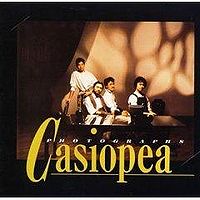 By this time, Casiopea’s reputation was starting to spread outside Japan, and in 1983 the band performed live in England for the first time. Later that same year, they recorded their tenth album, Jive Jive, in London.
By this time, Casiopea’s reputation was starting to spread outside Japan, and in 1983 the band performed live in England for the first time. Later that same year, they recorded their tenth album, Jive Jive, in London. 
In the summer of the following year, the band embarked on a European tour, followed by a trip to New York for the recording of Down Upbeat, and in the summer of 1985, the band went out on the road yet again. After a series of concerts in Europe, the quartet travelled to Southeast Asia for the second leg of their tour, and a few months later, a new studio album entitled Halle was released. During the recording of this album, the relations between the group members were starting to get strained, but in the end, the band decided to stay together, perhaps encouraged by the huge success of Halle, which turned out to be the biggest-selling album in the band’s history up to that point.
T he year 1989 turned out to be a watershed in Casiopea’s career. After a few years of tension within the band, drummer Akira Jimbo and bassist Tetsuo Sakurai left to pursue solo careers (to be covered in future editions of this column), and the two remaining members came close to calling it quits. It is the only year in the band’s history that did not see the release of a studio or live album from the fusion foursome. A laserdisc was released, but no album. However, replacements were found, and in 1990, Casiopea returned with The Party, the first album to feature new members Yoshihiro Naruse and Masaaki Hiyama. With his energetic stage presence, Naruse seemed to inject some new energy into the band, and the quartet was set to enter the 90’s with a more aggressive and slightly more hard-edged sound. One of Japan’s premier bass players, Naruse has a distinct style (partly due to his frequent use of double strings), and like Sakurai before him, is a master slapper.
he year 1989 turned out to be a watershed in Casiopea’s career. After a few years of tension within the band, drummer Akira Jimbo and bassist Tetsuo Sakurai left to pursue solo careers (to be covered in future editions of this column), and the two remaining members came close to calling it quits. It is the only year in the band’s history that did not see the release of a studio or live album from the fusion foursome. A laserdisc was released, but no album. However, replacements were found, and in 1990, Casiopea returned with The Party, the first album to feature new members Yoshihiro Naruse and Masaaki Hiyama. With his energetic stage presence, Naruse seemed to inject some new energy into the band, and the quartet was set to enter the 90’s with a more aggressive and slightly more hard-edged sound. One of Japan’s premier bass players, Naruse has a distinct style (partly due to his frequent use of double strings), and like Sakurai before him, is a master slapper.
In 1994, Casiopea was particularly busy. May saw the release of Answers, a new studio album recorded in Hawaii. For its 25th album, released only three months later, the band decided to try something different. The result was Hearty Notes, a kind of “unplugged” recording featuring only acoustic instruments. In December followed Asian Dreamer, a double CD containing new versions of 20 classic Casiopea songs.
Not about to slow down even after this busy year, Casiopea returned in 1995 with a new studio recording called Freshness. In 1996, the band appeared at the North Sea Jazz Festival in the Hague, Holland following the recording of a new album in Amsterdam. Later that year, Kumagai left the band, and rather than finding a permanent replacement, the remaining members decided to call upon a couple of old friends for the recording of their next album, Light and Shadows. Reuniting with Harvey Mason, the band recorded three tracks in L.A., while former member Akira Jimbo occupied the drum chair on the remaining eight tracks.
DISCOGRAPHY
- Casiopea (1979) – the band’s debut
- Eyes of the Mind (1981) – one of their best releases from the early 80’s, produced by Harvey Mason
- Mint Jams (1982) – a live album capturing the band at its best in the early 80’s
- 4 x 4 – Four By Four (1982) – a collaboration with Lee Ritenour, Don Grusin, Harvey Mason, and Nathan East
- Down Upbeat (1984) – one of the band’s best mid-80’s albums
- World Live ’88 (19888) – a live album containing material from the band’s late-80’s releases
- Active (1992) – one of the best studio albums with the new lineup
- Dramatic (1993) – one of the band’s best and most varied 90’s releases
- Material (1999) – Casiopea’s best studio album in a few years, featuring a horn section that adds some spice to the arrangements
- 20th (2000) – a double live album containing a 37-minute medley and featuring former members as special guests


